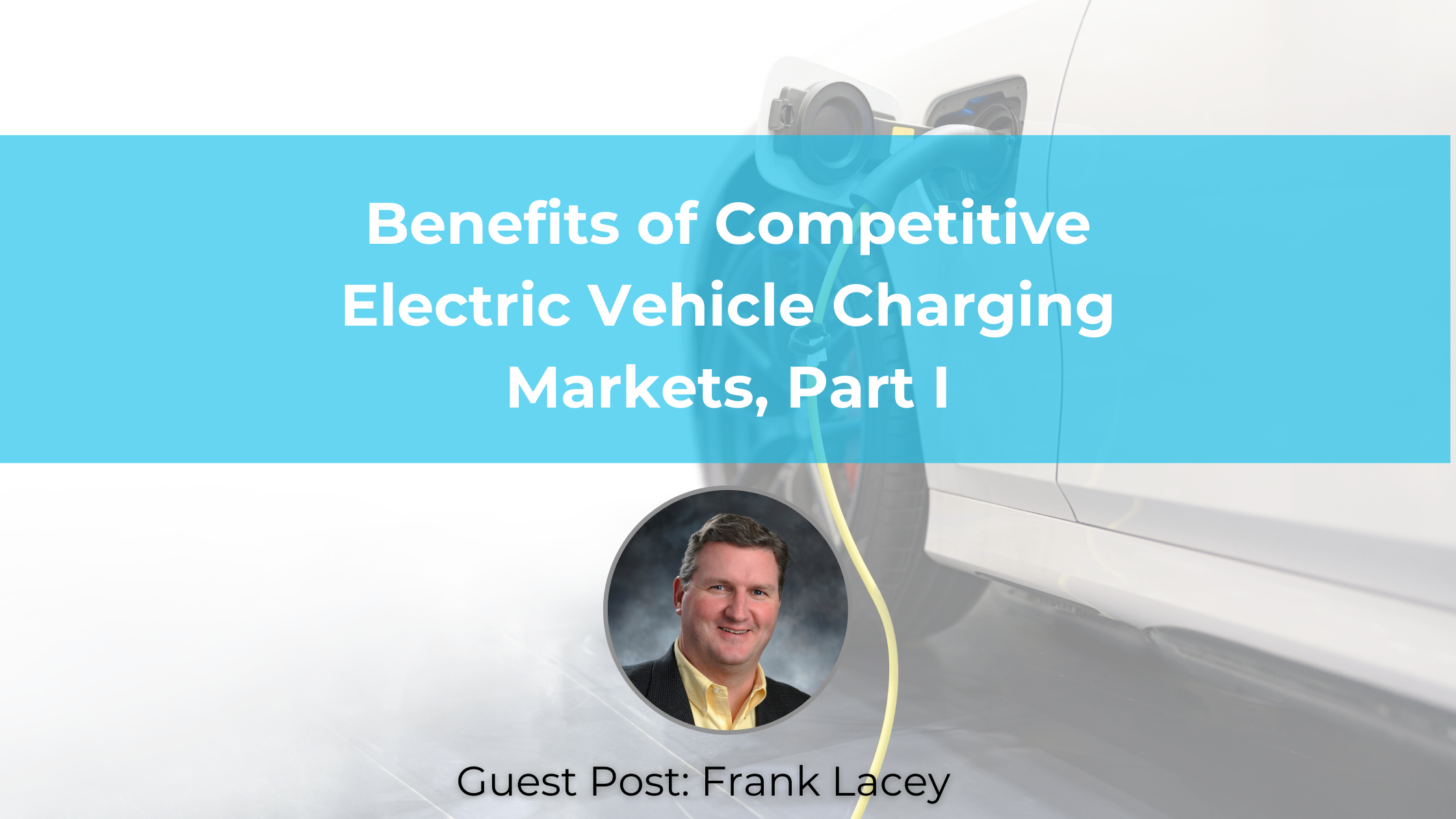
Guest post by: Frank Lacey
Electric vehicles (EV) are poised to fundamentally change at least two different industries – the automobile industry and the industry around “fueling” the cars. We have already seen the beginning of the automobile transition. It’s not possible to drive anywhere today and not see an EV on the road or parked nearby. Almost every automobile manufacturer has made public commitments to EV development. This transition is happening because these companies are envisioning a growing consumer demand for EVs. They are proactively modifying their product lines to meet consumer demands. This is exactly what would be expected in a competitive market economy.
The transition from “fueling” to “charging” is different, however. This transition is going slower than many had hoped. The fundamental reason for the slowdown is that there is a policy argument about who should be able to own charging stations. Some people have argued that charging is different from fueling because it involves the sale of electrons as opposed to the sale of hydrocarbons. They argue that electrons are the domain of the electric utility and therefore, the electric utility should control EV charging stations. At the same time, there has been a tremendous amount of non-utility, private investment in EV charging stations.
Electric vehicle (EV) sales are projected to grow exponentially in the coming years, and the network of public charging stations to serve them must expand accordingly. “Range anxiety,” caused by the scarcity of charging stations, is one of the primary obstacles to consumer uptake of EVs. Utilities have argued that their investment in EV charging stations will help alleviate range anxiety.
State policy makers will decide who is allowed to own charging stations and on what terms in order to best facilitate the growing adoption of EVs. A recent study that I co-authored has shown that allowing utility ownership of EV charging stations is bad public policy. The paper concludes that regulators should proclaim EV charging to be a competitive service, removing utilities from the charging function. Regulators should then focus on policies to support the development of the charging network, which falls within the natural bounds of a monopoly utility. Fair competition in charging and electricity supply will lead to the best results for the build-out of EV charging, for consumer pricing of charging options, for service to EV drivers and to the elimination of range anxiety.
Many question why utilities shouldn’t participate in a competitive market for EV charging. Utilities shouldn’t participate in a competitive market because the nature of their monopoly gives them certain guarantees that private investors do not have, providing them with an almost insurmountable competitive advantage. For example, utilities benefit from recovery of costs from all ratepayers and an allowed rate of return on invested capital. That means if a utility invests $100,000 in capital to build an EV charging station, it will be allowed to recover, in its rates, the initial $100,000 in capital (over several years) and a profit, or return of somewhere between roughly $8,000 and $13,000 every year. The range in profits is because regulators determine each utility’s allowed rate of return and they vary. A utility is also allowed to recover from ratepayers any costs for the maintenance of the charging station.
In contrast, a non-utility owner has to develop a business plan around the investment in charging stations. The private investor needs to recover its costs from customers who purchase charging services. It doesn’t necessarily have to recover costs from the sale of electricity (although that should be allowed), but it must recover its costs, or it will go out of business. Regardless of how the revenues are earned, private investors are afforded no such luxury as a guaranteed recovery of costs or an allowed rate of return.
Utility ratemaking practices also allow for a significant cross-subsidy from within its customer base. It is indisputable that today, the overwhelming majority of customers of every utility do not own an EV. Yet those utility customers are supporting any EV driver who utilizes the services of a utility charging station. Utility ratepayers are subsidizing EV owners. To make matters more troubling for ratepayers, they could be subsidizing an EV driver from another utility or even another state. A Maryland ratepayer, for example, might be subsidizing a New Jersey resident who happens to stop at a Maryland utility charging station on their drive to Florida. By contrast, the private investor is only going to earn revenues from EV drivers and only the drivers that stop at that investor’s station. If the drivers don’t stop, the investor will not earn a return on its investment. The utility recovers costs and a profit even if no customers stop at their stations.
The utility ownership issues run much deeper than just recovery of rates and an allowed return on investment. Utility ownership of EV charging will disrupt the charging industry on a day to day basis and will disrupt other industries based on current utility plans and proposals. Utility rates are fixed for long periods of time. Utilities must seek regulatory approval for rate changes. However, electricity prices move up and down on an hourly basis in response to real time supply and demand balance. A utility charging station can keep its rates fixed for long periods of time and then will, with regulatory approval, collect any shortfalls in subsequent periods. A private charging station will have to move its prices, like fueling stations today, on a regular basis to capture changes in market conditions. In a volatile price environment, the utility price will always be out of sync with the rest of the market. This will lead customer flows to the utility charging station when it is cheaper, and to the private charging stations when those are less expensive. The utility price will always suffer from this regulatory lag, which will cause the utility to always send an inaccurate price signal and will create counter-cyclical revenue cycles in the market.
Various utility proposals around the country create more problems than they solve. Entergy New Orleans has requested funding to provide 30-50 charging stations where customers can charge for free. A private enterprise can not compete with that. Additionally, why would ratepayers in New Orleans want to “fill up” a driver who is potentially “just passing through” New Orleans? There are no socially-funded gasoline stations in New Orleans. Why is EV charging different? This is not a good policy outcome.
There are proposals to locate utility-owned charging stations in big box retail store parking lots. This expands the subsidization problem significantly. In a world with competing big box stores, perhaps a Red Store and a Blue Store, how will the utility figure out where to place chargers? The utility is going to pick winners and losers in this market. It is possible that the Blue Store has already made a commitment to installing EV charging stations, so the utility will work with the Red Store. In this scenario, utility ratepayers are now interfering in competitive markets in the big box retail industry, essentially providing a subsidy to the Red Store. Again, utility ownership of EV charging stations is bad policy.
Finally, I will turn to Maryland, where regulators have allowed utilities to place publicly available EV charging stations on state and local government properties around the state. These charging locations include an airport, courthouses, a library, a zoo, a Public Works Department facility, police stations and similar government properties around the state. These are not places a consumer would typically want to visit, especially, if on an extended drive, when a consumer will be looking for other services such as food and/or restroom facilities. Many of these locations are not open outside of normal business hours. That might not prevent charging, but it will further limit the services available to EV drivers.
The Maryland utility-owned charging stations present one significant question and both conceivable answers are troubling. Are these charging stations going to be used by the charging public? If the answer is yes, then the utility has effectively distorted the competitive market for charging. The more likely and more troubling answer is no. If they are not going to be used, then why are ratepayers being compelled to spend the money?
There are no good policy arguments supporting utility ownership of EV charging stations. Range anxiety is one of the most significant obstacles to EV adoption by consumers. It is not possible for any utility to alleviate the range anxiety problem. Because utility territories are limited in size, to the extent a utility is helping alleviate range anxiety, it is supporting EV drivers from other service territories. Range anxiety doesn’t arise because of local travel. The net result of utility investment in EV charging stations is a delay in the buildout of the charging network. This will perpetuate range anxiety. The most efficient manner for the market to address range anxiety is to allow the market to operate freely, to support private investment, and to eliminate subsidized competition.

About the author: Frank Lacey is an independent energy markets consultant focused on advanced energy strategies and issues. His firm, Electric Advisors Consulting, practices across North America and focuses on Policy, Sustainability and other energy issues.